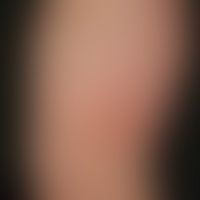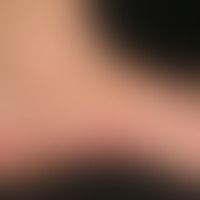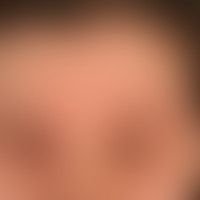Image diagnoses for "red"
877 results with 4458 images
Results forred

Stevens-johnson syndrome L51.1
Stevens-Johnson syndrome: acute with accompanying fever, occurred extensive, painful erosions of the red of the lips, lip mucosa and tongue in a 17-year-old woman. A few days later multiromic exanthema of the runp and face. The cause was probably the intake of ibuprofen.

Adult onset still disease M06.1
Still Syndrome adultes: maculo-papular (sometimes urticarial aspect) exanthema in 53-year-old patient with recurrent fever attacks, distinct feeling of illness, arthralgias, relevantly increased inflammatory parameters, negative ANA and rheumatoid factor; no monoclonal gammopathy (DD: Schnitzler Syndrome)

Morbus Morbihan L71.8
Morbihan, M.. Large red smooth spot, homogeneously affecting the whole face, chronically stationary, blurredly limited, sometimes accompanied by a feeling of tension; alternating intense redness; recurrent swelling of the eyelids.

Psoriasis arthropathica L40.50
Psoriasis arthropathica: single (only on the thumb), complete, crumbly onychodystrophy (psoriatic crumb nail) Massive swelling and redness of the entire thumb, infestation of the joints in the ray (so-called sausage fingers).

Dress T88.7
DRESS: Detailed picture. 4 weeks after taking carbemazepine, occurrence of this generalized maculo-papular exanthema.

Carcinoma verrucous (overview) C44.L
Carcinoma verrucous: long term unrecognised and treated as a "viral wart" In the presented case an amputation of the finger in the middle joint was performed.

Angioedema (overview) T78.3
angioedema. swelling of the lower lip and the right hand in a 57-year-old man occurred within a few minutes. persistent for 2 hours, no itching, only a feeling of tension. recurrent swelling attacks (interval of 14-28 days) for 6 months. 8 months ago change of the hypertension medication to ACE inhibitors.

Angry back T78.8
Angry back: Multiple "false positive" and clinically irrelevant test reactions in epicutaneous testing. 48h reading.

Papillomatosis cutis lymphostatica I89.0
Papillomatosis cutis lymphostatica. detail enlargement: brownish-red papules and plaques. in the center of the picture isolated scratch excoriations.

Airborne contact dermatitis L23.8
Airborne Contact Dermatitis: chronic (>6 weeks) extensive, enormously itchy and burning eczema with irregular, extensive infestation of the exposed facial areas including the eyelids.

Lichen planus exanthematicus L43.81
Lichen planus exanthematicus: an itchy exanthema that has existed for several months, with 0.1-0.2 cm large, slightly raised, disseminated, smooth, shiny, yellow-reddish, shiny papules.

Borrelia lymphocytoma L98.8
Lymphadenosis cutis benigna: soft, reddish-livid, blurred reddish-brownish lump at the edge of the auricle in the child, since 3 months.

Lichen planus (overview) L43.-
Lichen planus exabthematicus: unusual infestation of the soles of the feet, with itchy, red, in places confluent, smooth, shiny papules and plaques; skin lesions extend beyond the skin of the groin

Seborrheic dermatitis of adults L21.9
Dermatitis, seborrhoeic: Multiple, chronically stationary, centrofacially localized (also on eyebrows and in the beard area), almost symmetrical, blurred, at times slightly itchy, red, rough, finely scaled spots and plaques on the face of a 32-year-old HIV-infected person.

Seborrheic dermatitis of adults L21.9
Dermatitis, seborrhoeic: chronically recurrent disease with constant, blurred, sometimes slightly itchy, red spots and plaques; distinctly bds. eyelid eczema

Lupus erythematosus subacute-cutaneous L93.1
Lupus erythematosus subacute-cutaneous: Infestation of the palms in the cream of a generapized exanthema.








